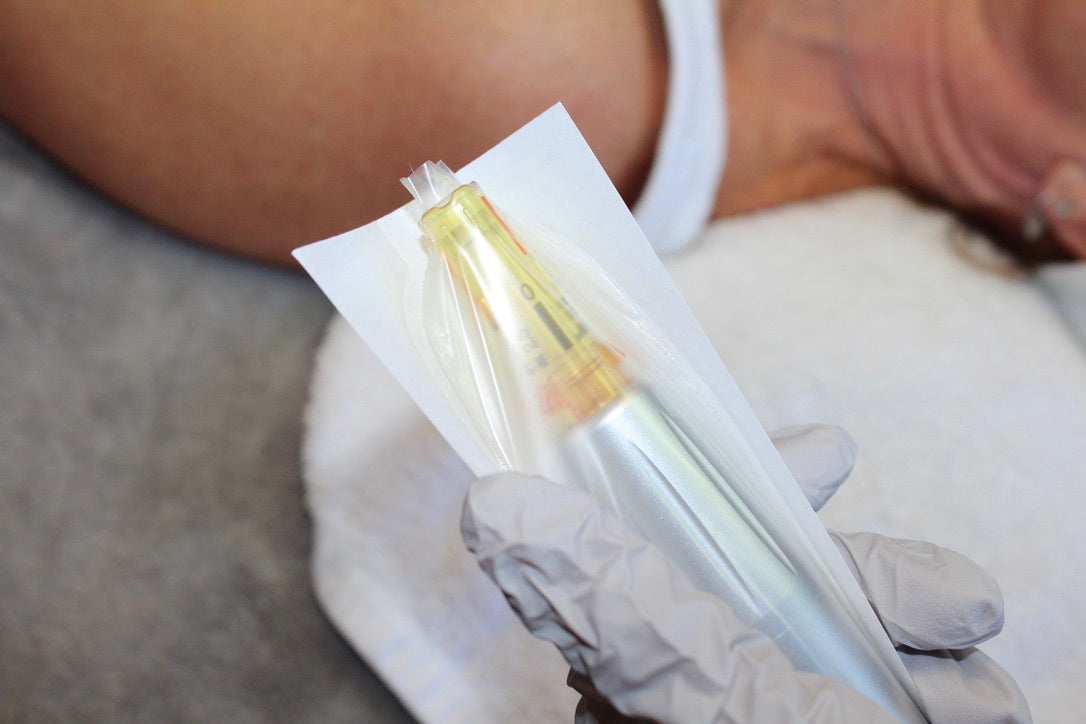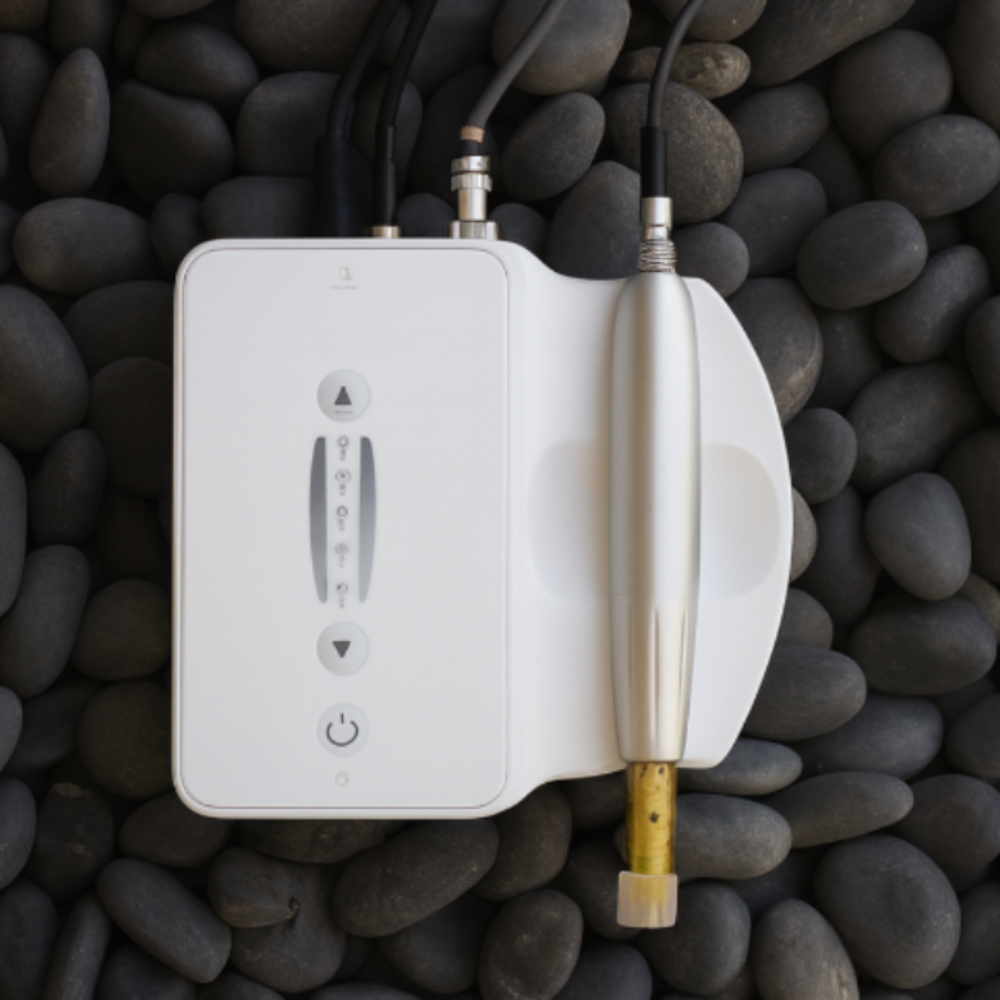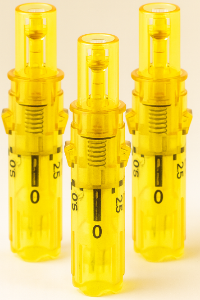Dermapen Dr Pen Microneedling by Dr Sasaki - Dermapen
Casey IsomBefore discussing the advantages of Dermapen Dr Pen I would like to touch on the history of needle dermabrasion and microneedling. Let's start with history of microneedling..
The earliest forms of microneedling were reported by acupuncturists in China, centuries ago. The concept of penetrating the skin and attempting to get material through the skin and return to needles was one of the first abrasion techniques used. There were different forms of dermabrasion that uses a wheel to take off a layer of skin or a deep chemical peel. The earliest practice of resurfacing with abrasion with a rotating wheel was in Germany in 1905. In the US, the notion of using a needle began around 1995 by dermatologist brothers in Philadelphia. They were using a bevel needle to treat scars and wrinkles. They were not aiming to make the skin look better, but rather for subdermal releases. We now move to the modern era of micro needling. It is defined as using either solid or hollow needles of the appropriate length and diameter to go through the skin epidermis/dermis. Microneedles were being used which really had to wait until technology caught up to actually produce them, because they are so tiny, like 300 microns diameter. If you try to make a hollow needle that small it's impossible until you have the technology that can produce it. So micro needling was really based on the ability to technologically produce these needles that transferred it from a macro to a micro needle to get through the epidermis, into the dermis for two reasons: first, and this is a dry micro needling technique, you use the needle by itself, and the needles can be a series of needles or a single needle, but you're just puncturing the epidermis and relying on the natural ability of the skin to respond by the normal wound healing efforts. You introduce the whole process of wound healing, all phases of normal healing, and therefore you make the skin better. That is a dry needling technique.
Dermapen dr pen or concept of using needles for the general health of individuals extended to other parts of the world, particularly France. Soon, both countries were using needles to stimulate specific acupuncture points to correct imbalances in the flow of natural energy through channels known as meridians. This same practice is the basis of acupuncture today. Micro needling is an age old, tried and true method that was basically being administered in ancient times but with motionless needles. >The concept of penetrating the skin and attempting to get material through the skin and return to needles was one of the first abrasion techniques used. There were different forms of dermabrasion that uses a wheel to take off a layer of skin or a deep chemical peel. The earliest practice of resurfacing with abrasion with a rotating wheel was in Germany in 1905. In the US, the notion of using a needle began around 1995 by dermatologist brothers in Philadelphia. They were using a bevel needle to treat scars and wrinkles. They were not aiming to make the skin look better, but rather for subdermal releases. We now move to the modern era of micro needling. It is defined as using either solid or hollow needles of the appropriate length and diameter to go through the skin epidermis/dermis. Microneedles were being used which really had to wait until technology caught up to actually produce them, because they are so tiny, like 300 microns diameter. If you try to make a hollow needle that small it's impossible until you have the technology that can produce it. So micro needling was really based on the ability to technologically produce these needles that transferred it from a macro to a micro needle to get through the epidermis, into the dermis for two reasons: first, and this is a dry micro needling technique, you use the needle by itself, and the needles can be a series of needles or a single needle, but you're just puncturing the epidermis and relying on the natural ability of the skin to respond by the normal wound healing efforts. You introduce the whole process of wound healing, all phases of normal healing, and therefore you make the skin better. That is a dry needling technique.
That technique really was used in the early phases of micro needling and the early phases began in 1996. Dermatologist, Dez Fernandez started using a round platform stamp and in that stamp he embedded 25 needles which protruded about 1-2mm from the surface. He stamped the patient under local anesthetic and it was only used for skin rejuvenation based on the cascade of normal healing. A year later in 1997, a plastic surgeon from Montreal used the needles, not to improve appearance of the skin, but to treat scars. When you look at mature scars, they are white in color. When he used the micro needling technique, he brought in melanocytes to populate the scars, duplicating the surrounding skin. Eventually he graduated to using the tattoo gun. He used the gun to put pigments on the skin and drive in the pigments to blend the hypo pigmented scars and give them a more natural color. Using the tattoo gun without pigmentation, he found the scar looked better in terms of color and also improved its raised and angry look.
The modern era of needling began in about 2000. A German dermatologist by the name of Dr. Schwarz, trademarked what is now referred to as the derma roller. The derma roller device is like a wheel barrel, about 2.5cm across. He placed needles that were preset to certain depths that could not be changed. Under local anesthetic, he would roll this wheel barrel which had the needles sticking out of it, and was able to show in 2004 that the dermis became thicker, creating rejuvenation. This was all dry technique, just reusing the wheel over the area. There are two restrictions to point out here: the needles were preset in depth and cannot be changed, and the speed can't be modified either, given that it is a manual device. In addition, the device was cumbersome and did not allow access to all areas of the face. But the idea was innovative because it did show rejuvenation of the skin, both in the epidermis and dermis.
In 2006, Dr. Schwarz began referring to the dermal roller technique as collagen induction therapy, which was an extension of the research on the cascade of wound healing and subsequent collagen induction. According to his research there was a 200% increase in collagen from the penetration of the needles. In addition, the new the collagen was confined to the 500 micron level of the dermis, the upper third of the reticular dermis. Going deeper, like a 1.5mm needle or 2.5mm needle, the response of the collagen would only be in the upper third. So the area of improvement was in upper third of the dermis, regardless of the depth of the needle. Then in 2010, plastic surgery researched showed a 140% increase in epidermal thickness and dermal thickness. All these studies that have been presented and published show epidermal improvement and dermal improvement about 150% to 200% baseline over time.
Then in 2010, plastic surgery researched showed a 140% increase in epidermal thickness and dermal thickness. All these studies that have been presented and published show epidermal improvement and dermal improvement about 150% to 200% baseline over time.
Unlike the micro-needling devices in the past, Dermapen dr pen does not roll manually over the skin, it is a sleek, pen-like instrument that glides across the face. It is equipped with 11 33 gauge needles embedded into a disposable applicator. All you do is take the applicator and the disposable so it's a one time use per patient, and attach it to the pen. The pen has an electric motor so it's not battery powered. The motion of the needle moves up and down with a stamping effect. The vertical intrusion is important because it causes less trauma then when the wheel barreling technique. Wheel barreling causes tearing, rather than stamping.The beauty of this device is the adjustable needle depth from 0.25mm up to 2.5mm. The epidermis is only about 100 microns in depth. The reticular dermis is about 2500 to 3000 microns in depth, so if you're on the 2.5, that's 2500 microns. When using that setting you're on the lower section of the reticular dermis. When you're using the 0.25 you're just in the upper part of the reticular dermis. There is variability in the needle depth, which is important when you're doing facial or non facial work because certain parts of the face, like the upper lip or lower lip skin, is thicker. Generally we like to work at the 1.5-2.5mm depth. If you go to the upper lip skin, you're at the 2.5 level. If you use the wheel barrel, precision like this is not possible and there is no depth variation. With Dermapen you can vary the depth and the frequency. If you want to work slowly you work at one setting; it is calibrated to setting 1. If you want to work really fast you work at the 6-7 setting. The device glides over the skin in a stamp-like fashion while sweeping across the face. This requires slippage, which is a topical for the skin that allows you to move the disposable head across the face without it catching. In this case we would use hyuluronic acid.
The three most important components of the Dermapen dr pen is that it's disposable, there is no cross-contamination and has varying speeds and depth. This is all dry technique. If you use dry technique, whether you do it on the face or off the face (which we'll get into) that's all you need to do and you get the result because you're relying on the normal cascade wound healing to introduce and stimulate collagen within the dermis of the skin.
When you're using micro-needling technique, the window of time you have to get the material into the skin is about 10-15 minutes.
Remember when you're doing transdermal delivery without a micro-needle, the molecule has to be lypophyllic. Secondly, the molecule has to be like 500 daltons in dims, but TINY. The molecule needs to be very small and lypophyllic. This is done on the skin so the question is how in the world is this material getting through the intact stratum cornium? The answer is that it goes between the cells or they go through the normal pores to the skin, hair follicle and sebaceous gland. It becomes an inefficient way to get materials through the in tact stratum cornieum. Suddenly micro-needling comes on board, and is making these little micro pore channels. The other way was very, very difficult. There have been different methods, but they cost a lot of money whereas micro-needling is very affordable. Once you get involved with micro-needling as a transdermal device, you can put in larger molecules and cells that don't have to be lypophyllic. You can get greater amounts in without worrying much about microbial penetration because the pores close within 10-15 minutes.
Here at my office we are using the Dermapen dr pen microneedling. We favor this approach for wrinkles, fine lines, rejuvenation, superficial pigmentation, minimizing skin pores, improving stretch marks, crepey skin, surgical scars, acne scars and even hair growth. We use the platelets to stimulate dormant hair.
Another thing I love about Dermapen dr pen is that it can be used on any type of skin. I've used it on atrophic hand skin on patients who are paper thin, including the thin skin inside the arm. You have to be careful where you have active infections however, like acne. In this instance you would want to work at a lower setting. But I don't see any skin that would not benefit from Dermapen treatment.
Dermapen dr pen has two models. One is only to be used by the skin care aesthetician/medical assistant. They are only to go down to certain micron depths. The medical individual will go up to 2.5 mm depth. Once you're using cosmeceuticals, the skin care people can use it with Dermapen dr pen.
In my experience, Dermapen dr pen has delivered some dramatic results. For fine lines around the upper and lower lip, very good. Acne scars, very good. wrinkled skin to the decolatage to the inner arm area, very good. It's also great for general skin rejuvenation. We administer Dermapen as an isolated event or combine it with medical skin care programs with LED light sources. IPL was originally developed for rosacea and for pigment. It really was not developed for skin rejuvenation.
| The Dermapen Microneedling Pen provides an unparalleled response through the segmented delivery of microneedles, creating micro injuries to the epidermis (outer layer of skin) and dermis (the inner layer of skin). As a result, the micro injuries encourage the body’s innate ability to repair itself. | Every Dermapen tip is outfitted with 12 needles and features our patented technologies, which include SureSpace™ and SafLok™. Accordingly, these safety enhancements can be found in every Dermapen needle tip and pen. | Furthermore, by using SureSpace™ and SafLok™ microneedling pen technologies, practitioners can deliver their patients the safest microneedling treatment possible, while getting the best microneedling results for their patients. |
| Medical practices and licensed skin care professionals around the world offer their patients the worlds most advanced microneedling treatments with Dermapen® |
| Dermapen® Microneedling Devices are exclusively sold to Medical and Skin Care Professionals. Use the form to the right to get started finding a Certified Dermapen® practitioner in your area. |




